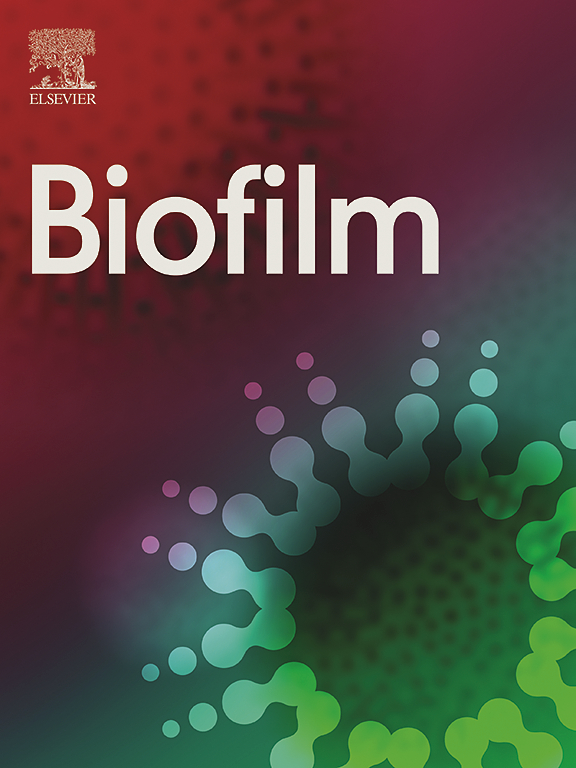Synergistic combinations of novel polymyxins and rifampicin with improved eradication of colistin-resistant Pseudomonas aeruginosa biofilms
IF 4.9
Q1 MICROBIOLOGY
引用次数: 0
Abstract
Background
Increased prevalence of antimicrobial resistance coupled with a lack of new antibiotics against Gram-negative bacteria emphasize the imperative for novel therapeutic strategies. Colistin-resistant Pseudomonas aeruginosa constitutes a challenge, where conventional treatment options lack efficacy, in particular for biofilm-associated infections. Previously, synergy of colistin with other antibiotics was explored as an avenue for the treatment of colistin-resistant infections, and recently we reported our efforts towards colistin analogs capable of combating planktonic colistin-resistant strains.
Aims
The aim of the present study was to investigate whether analogs of polymyxin B with improved potency in wild-type and moderate resistant Gram-negative pathogens would retain similarly increased activity in highly colistin-resistant clinical P. aeruginosa isolates (in planktonic and biofilm growth) when applied alone and in combination with rifampicin.
Materials and methods
In this in vitro study, we tested three analogs of polymyxin B prepared by solid-phase peptide synthesis. Antimicrobial susceptibility testing was performed by measurement of minimum inhibitory concentrations via the broth microdilution method. Interactions between two antimicrobials was quantified in a checkerboard broth microdilution assay by calculating the fractional inhibitory concentration index for each combination. For testing of antibiofilm activity a previously described model with alginate beads encapsulating a biofilm culture was applied. The minimum biofilm eradication concentrations (MBECs) were evaluated, and the fractional biofilm eradication concentration indices were calculated. Three recently identified colistin analogs (CEP932, CEP936 and CEP938) were tested against three isogenic pairs of colistin-susceptible and colistin-resistant P. aeruginosa clinical isolates as well as the reference strain PAO1.
Results
For bacteria in planktonic growth CEP938 retained almost full potency in all three resistant isolates, while exhibiting similar activity as colistin in susceptible isolates. Against biofilms CEP938 was slightly more potent against PAO1 as compared to colistin, while also retaining activity against a biofilm of the colistin-resistant strain 41,782/98. Next, synergy between CEP938 and the antibiotic rifampicin was explored. Interestingly, CEP938 did not exhibit synergy with rifampicin in planktonic cultures. Importantly, for colistin-resistant biofilms the CEP938-rifampicin combination demonstrated activity superior to that found for the colistin-rifampicin combination.
Conclusions
The present study showed in vitro efficacy of CEP938 against both colistin-susceptible and colistin-resistant P. aeruginosa biofilms as well as an ability of CEP938 to synergize with rifampicin in biofilm eradication.
新型多粘菌素和利福平的协同组合能更好地根除耐大肠菌素铜绿假单胞菌生物膜
背景抗菌素耐药性的增加,加上缺乏针对革兰氏阴性细菌的新型抗生素,强调了新型治疗策略的必要性。耐大肠杆菌素的铜绿假单胞菌是一项挑战,传统的治疗方案缺乏疗效,尤其是对生物膜相关感染。以前,人们曾探索过将大肠杆菌素与其他抗生素协同作用作为治疗耐大肠杆菌素感染的途径,最近,我们报告了我们在开发能够抗击浮游大肠杆菌素耐药菌株的大肠杆菌素类似物方面所做的努力。本研究的目的是探讨在单独使用或与利福平联合使用时,对野生型和中度耐药革兰氏阴性病原体具有更强效力的多粘菌素 B 类似物在对高度耐大肠杆菌素的临床铜绿假单胞菌分离物(浮游和生物膜生长)中是否同样具有更强的活性。通过肉汤微稀释法测定最小抑菌浓度,进行抗菌药敏感性测试。在棋盘格肉汤微稀释试验中,通过计算每种组合的抑菌浓度分数指数来量化两种抗菌剂之间的相互作用。在测试抗生物膜活性时,采用了之前描述的海藻酸珠包裹生物膜培养物的模型。评估了最小生物膜根除浓度(MBECs),并计算了生物膜根除浓度分数指数。结果对于浮游生长的细菌,CEP938 在所有三种耐药分离物中都几乎保持了全部效力,而在易感分离物中则表现出与秋水仙碱相似的活性。与可乐定相比,CEP938 对生物膜 PAO1 的作用稍强,同时对可乐定耐药菌株 41,782/98 的生物膜也具有活性。接下来,研究人员探讨了 CEP938 与抗生素利福平之间的协同作用。有趣的是,在浮游培养物中,CEP938 与利福平没有协同作用。重要的是,对于耐大肠杆菌素的生物膜,CEP938-利福平组合的活性优于大肠杆菌素-利福平组合。结论本研究显示了 CEP938 对大肠杆菌素敏感和耐大肠杆菌素的铜绿假单胞菌生物膜的体外疗效,以及 CEP938 与利福平协同消灭生物膜的能力。
本文章由计算机程序翻译,如有差异,请以英文原文为准。
求助全文
约1分钟内获得全文
求助全文

 求助内容:
求助内容: 应助结果提醒方式:
应助结果提醒方式:


